
Cycas revoluta: 10 questions & answers
And our tips!
Contents
Cycas are strange prehistoric bushes, often compared with arborescent ferns or palms because of their appearance, which charm with their archaic, exotic appearance. They unfurl a magnificent crown of long green fronds gracefully arching over a brown, fibrous trunk, as with Cycas revoluta, most commonly grown. Tender, these fossil trees are only grown outdoors on Mediterranean or Atlantic coastlines. Generally, they do not exceed 1.5 m in height, which allows them to be grown in pots or tubs in our coldest regions.
When and how to plant a cycas, how to take a cutting of cycas, why my cycas is turning yellow etc, here are answers to 10 most frequently asked questions you have about this mysterious plant!
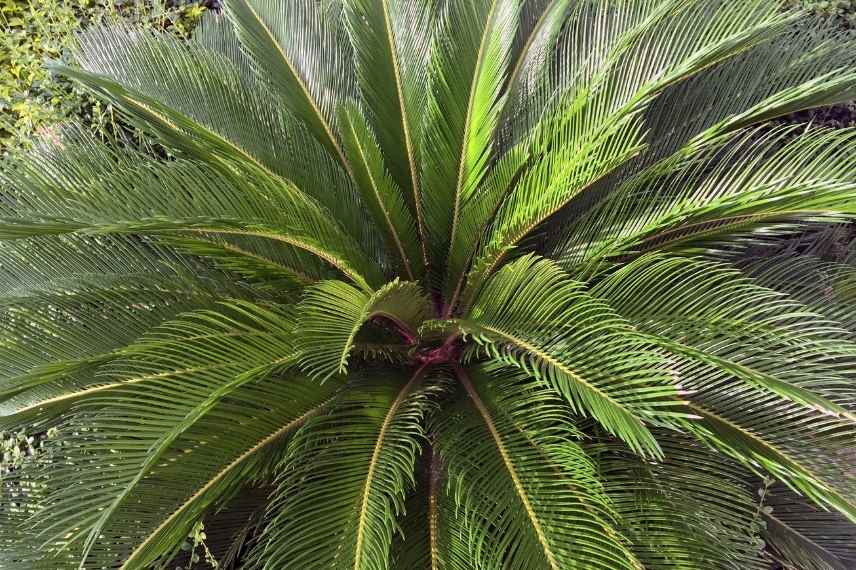
Cycas revoluta
Why are the leaves (fronds) of my cycas yellowing?
If old leaves (fronds) are yellowing, and the plant continues to produce new leaves, this is normal, because Cycas fronds renew every year or every two years or so. They turn yellow when they get too old. Simply cut off these yellowed fronds regularly at the base of stipe; new petioles will regrow. Other causes are also possible :
- Leaf yellowing is often caused by a deficiency. A nitrogen, manganese or magnesium deficiency shows as yellowing of leaves. Cycas need regular fertiliser. An application of turf and/or compost around the base of the plant can help correct the problem.
- Cycas can yellow when they lack water. They prefer soil that stays cool in summer. In the garden, your Cycas need some regular watering, but not excessive; once a week during their first two summers helps them establish roots, especially during prolonged drought. In a pot, water about once a week during the growth period, allowing soil to dry between waterings.
- Leaf yellowing can also be caused by overwatering. If so: stop watering and let substrate dry out thoroughly before watering again. Because Cycas’ worst enemy is stagnant moisture at roots, don’t hesitate to improve drainage when planting and avoid water-retaining trays for specimens grown in pots to prevent root rot. Water must drain away quickly. If necessary, repot into fresh, dry, well-draining soil after first spreading a good layer of gravel at the bottom of planting hole or pot.
- Finally, leaf yellowing can be a consequence of frost damage.
My advice: in all these cases, cut off yellowed fronds.
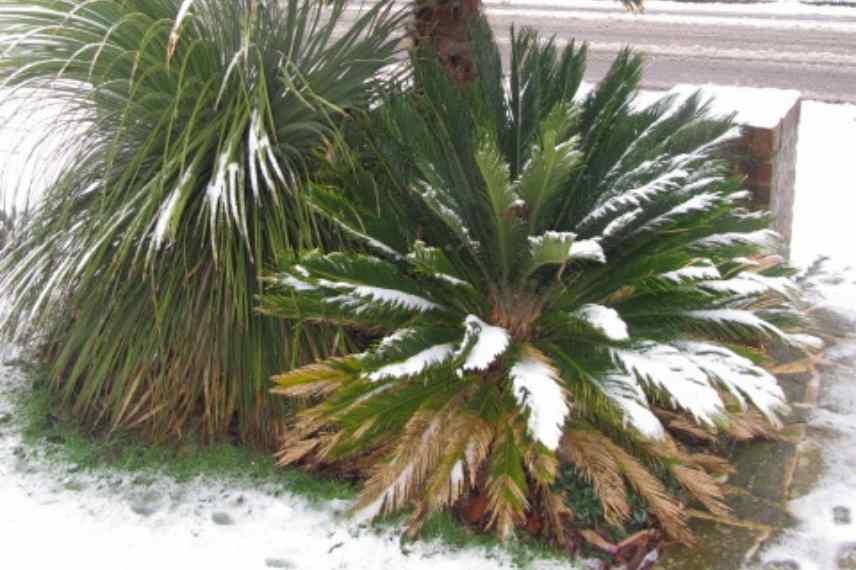
Here, Cycas leaf yellowing is due to cold (© Leonora Enking)
Read also
How to protect Cycas in winter?How to save a Cycas?
Cycas is a fabulous plant but not very hardy. Even in our mildest gardens, Cycas are not immune to a frost. Fronds discolour, yellow, then dry out. If the foliage has been scorched by a frost, do nothing at first! Leave yellow or brown leaves in place; they will serve as blanket bog to the trunk during the rest of the cold season, allowing new petioles to regrow nice and warm. It is quite possible Cycas will reshoot from the base; new green fronds will develop during spring. Recovery will depend on intensity and duration of the frost. When frosts are no longer a threat, you can cut leaves damaged by the cold, flush with the stipe. And avoid overwatering it until it shows real signs of recovery!
In general, if your cycas looks poorly, check watering and drainage. To save it: let substrate dry out between two waterings and reduce waterings. Waterings should be moderate so as not to asphyxiate the roots. It should be neither too excessive nor too sparing. You can also apply some fertiliser to stimulate it.
If, on the other hand, you notice the stipe is soft, it is probably too late and it has started to rot. Cause: poorly drained soil. Cycas are very susceptible to rot. To avoid this kind of problem, when planting, whether in a pot or in open ground, add gravel or pumice. Keep its feet out of the water.
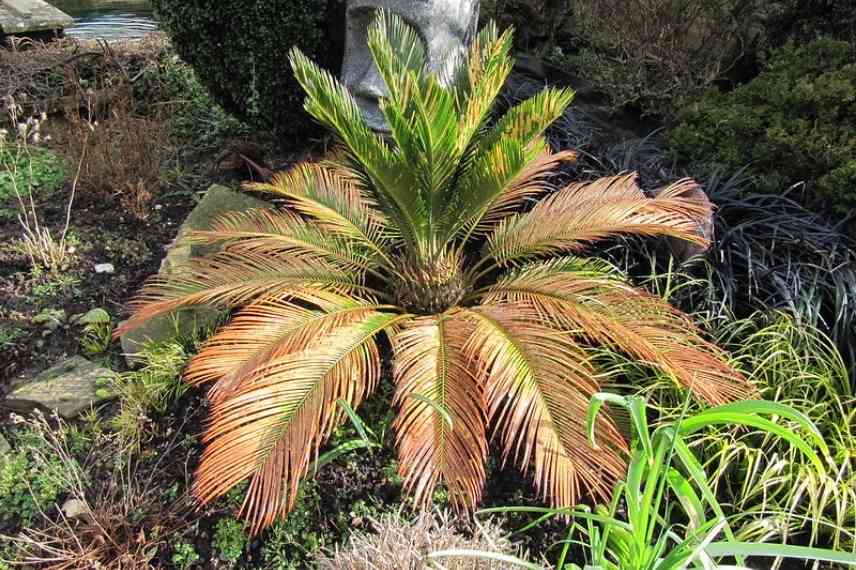
A Cycas in February reshoots from the centre. Simply remove leaves damaged by the cold (© Leonora Enking)
Which fertiliser for cycads?
Cycads are fairly demanding; we recommend applying slow‑release fertilisers rich in nitrogen. For example, you can give them an organic fertiliser for palms, yuccas and cycads, derived from composted plant and animal matter or horn meal, guano or blood meal or well‑rotted compost in spring. This helps to thicken foliage, stimulate growth and promote sturdiness of trunks, without risk of root burn.
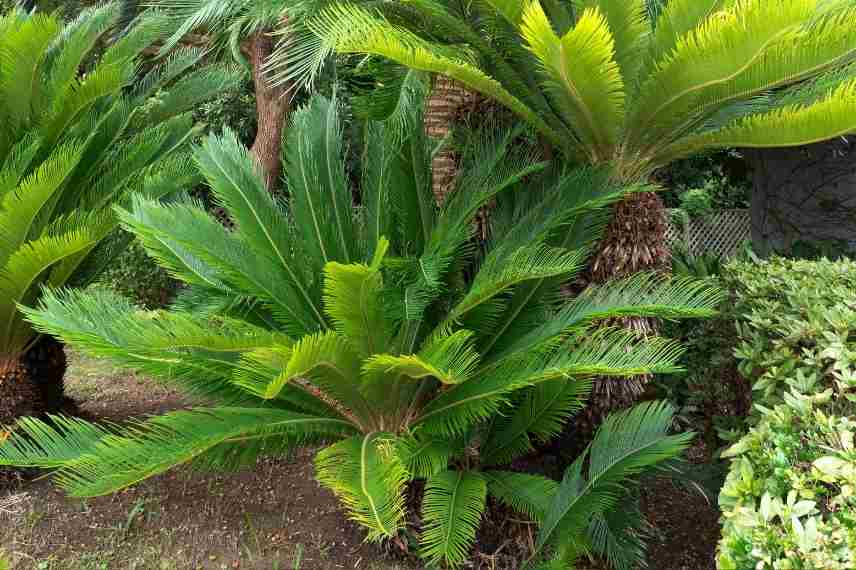
Read also
Cycas revoluta: 10 questions & answersWhen and how to plant a Cycas?
When to plant?
Cycas are planted in open ground in May–June after frosts or in late summer from September to October in mild climate, so they can root well before winter. They need warmth to establish.
How to plant?
In open ground
One essential requirement: good drainage! If soil is heavy, I suggest mixing garden soil with about one third coarse sand or gravel to improve drainage. Choose a sunny, sheltered site protected from prevailing winds.
- Loosen soil well
- Dig a hole 2 to 3 times volume of rootball
- Lay a drainage layer at bottom of hole
- Plant with cycas positioned upright; leave rootball intact
- Backfill with equal parts garden soil, potting compost, compost and sand
- Avoid burying base of stipe
- Firm lightly and water generously, then regularly during first season of growth to help it root
- Mulch stump so soil remains cool
- Stake if exposure is windy
In a pot
In colder regions, Cycas grow very well in a large pot that you can bring outside in the warmer months, or keep indoors in a very sunny, bright spot.
- Place a drainage layer at bottom (clay balls, pumice — about 20% of container volume) in a container with drainage hole
- Plant your cycas in a free-draining mix made of garden soil, potting compost or compost and one third coarse sand
- Avoid burying its collar
- Water generously
- Repot only every three years
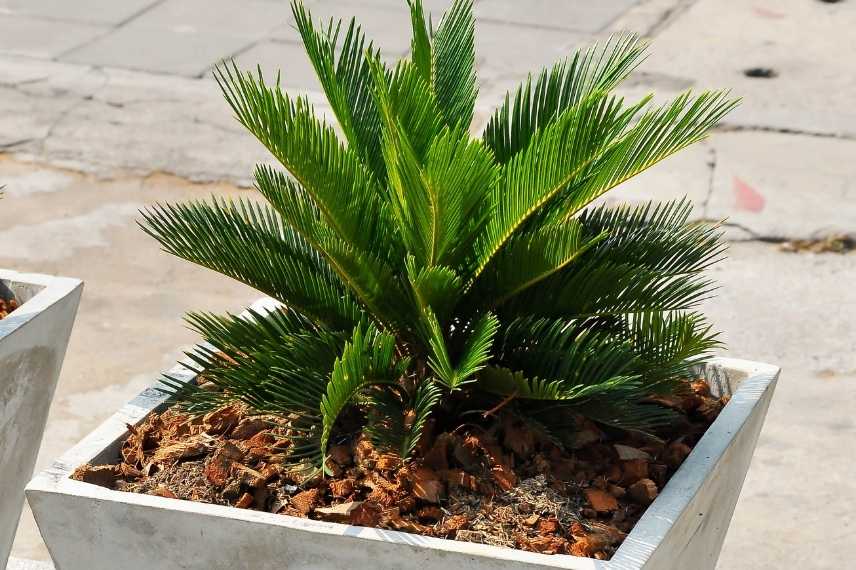
Young Cycas planted in pot
How to get Cycas seeds germinating?
Cycas revoluta is a dioecious plant, which means there are male and female plants, each producing distinct reproductive structures in the form of cones (these are not strictly speaking ‘flower’, but ‘cone’). Male and female plants must be planted close together to obtain seeds. Without a male plant, female Cycas may still produce seeds without being fertilised, but these are sterile and will not germinate.
Note also that in Cycas, seed formation occurs only on mature specimens and is extremely rare in plants grown in pots. If you manage to obtain seeds, first congratulations, but be aware that sowing will also be an achievement… because germination is particularly slow! Expect to wait about 1 to 2 years before the very first fronds appear.
- If pollination has occurred by chance, collect the large bright-red seeds
- Soak seeds in water for around ten days to speed up germination by a few days
- Sow one or two cycas seeds in buckets filled with turf and moist sand
- Place in a warm greenhouse, a heated mini greenhouse or near a radiator: ideal temperature around 20–25 °C
- And be patient: baby cycas will not appear before at least 10 months!
- Transplant young plants into garden or pots when they are sufficiently vigorous and robust
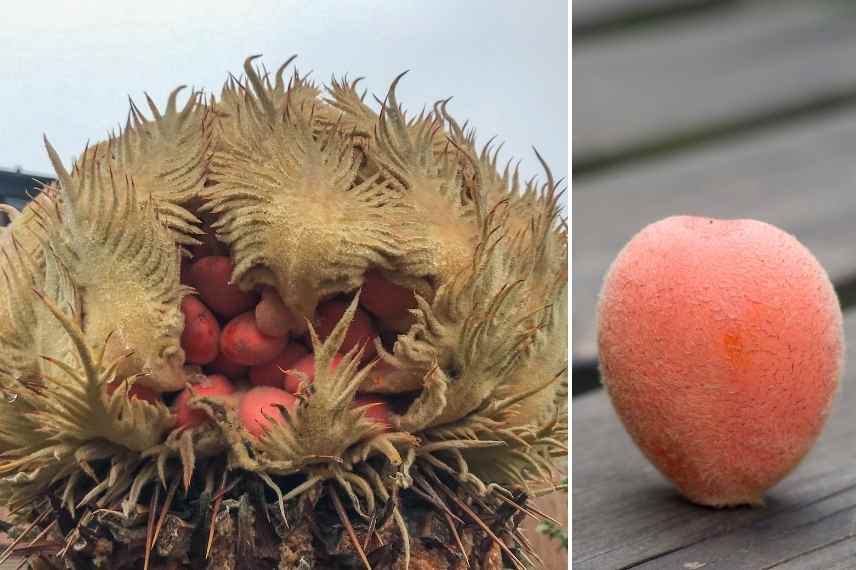
Seeds of Cycas revoluta
How to recognise a male cycas from a female?
Reproductive cones of Cycas appear at the heart of the foliage. In females, these cones take the form of a ball of ochre-yellow leaves. In males, they form a large cone scaly and erect 30 to 80 cm long, pale yellow. They contain pollen grains that will fertilise ripe ovules borne on female flowers.
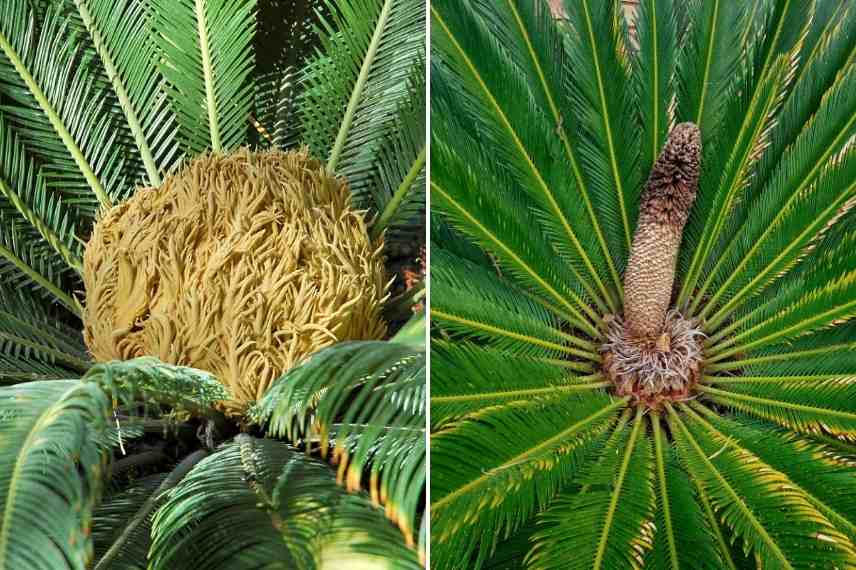
Female Cycas and male Cycas
Should you cut off a Cycas cone?
In our latitudes, development of summer cones on Cycas is quite rare! Far from its native habitat, Cycas struggles to produce cones. Development of these reproductive structures occurs only on older specimens. You sometimes have to wait more than twenty years for the chance to see one! It is almost non-existent in potted plants. So why deprive yourself of this rarity? Let it develop, you can cut it off at the base once it has withered.
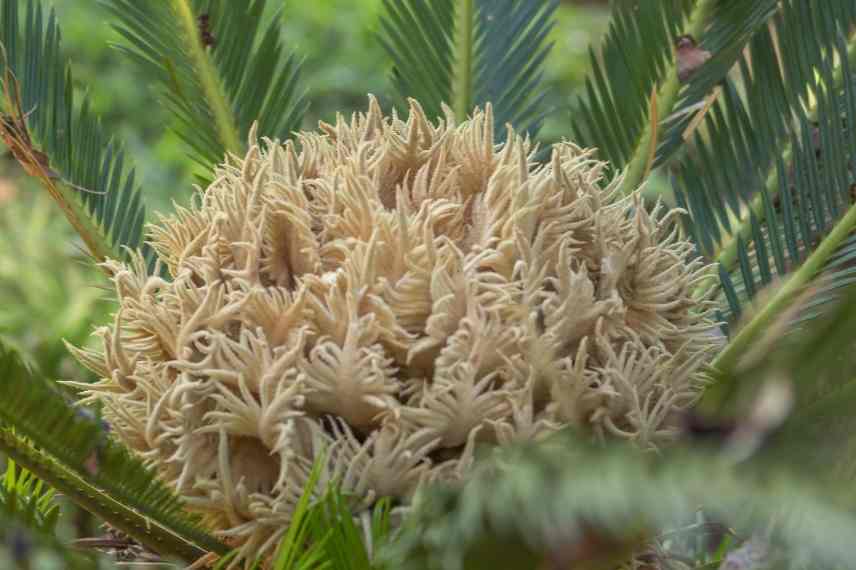
Female cone of Cycas
When to prune a cycas?
Cycas does not strictly require pruning. Simple cleaning of old leaves in early spring is sufficient. We recommend pruning fronds only when they have yellowed or are completely dry. After winter, wear gloves to protect against thorny petioles. Remove fronds by cutting them at the base of the stipe.
How to remove suckers from a Cycas?
Suckers are very common on Cycas. They are new shoots that form from the roots of the mother plant. These suckers exhaust the plant unnecessarily. Removing them will concentrate the sap in the stipe and promote optimal growth of the mother Cycas. In March, before vegetative growth resumes, cut the suckers at their base with a very sharp knife. They can be kept to produce new plants.
→ For more information, also read our article :“Cycas: how to separate and replant new shoots?”.
How to take cuttings from a Cycas?
Your Cycas is producing suckers? Make the most of them! You can also multiply it by lifting these new plants that appear around the trunk in spring. It’s a simple, opportunistic propagation method! They will produce cycas identical to the mother plant. Wait until these suckers are well formed and have at least 2 or 3 healthy leaves.
- In March, cut the suckers cleanly at their base with a knife
- Cut the fronds in half to limit evaporation
- Leave the suckers to dry for a few days in a shaded place
- Plant each cutting upright in a bucket, pushing two-thirds of the stems into a mix of potting compost and sand to encourage rooting
- Firm the soil around the collar
- Place the cuttings in a warm greenhouse or somewhere with sufficient warmth to ensure good establishment
- Water regularly
- You can then pot up young Cycas into larger pots
- Planting out will only be possible when they are vigorous; rooting takes at least six months
- Subscribe!
- Contents
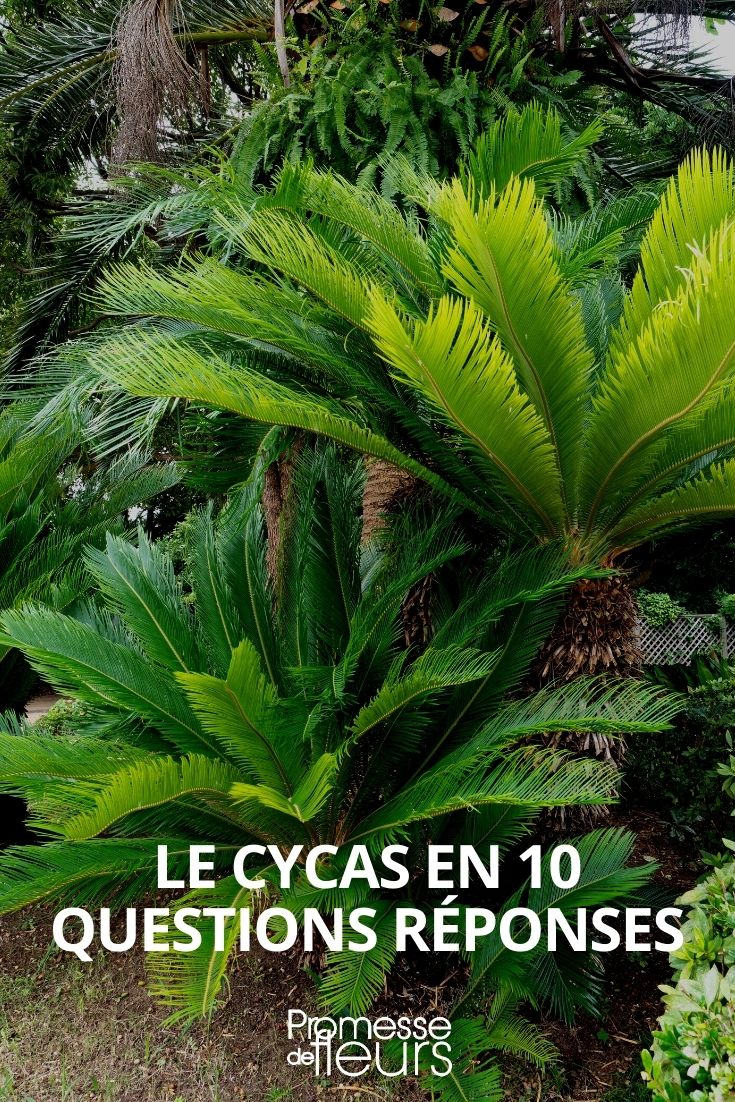































Comments